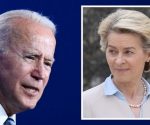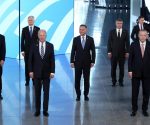Who is Shinzo Abe, Japan’s departing prime minister, and what legacy will he leave?
[ad_1]

Abe has served as Japan’s premier since 2012 and, before that, from 2006 to 2007, maintaining a strong international presence during his time in office. He has left an indelible mark on the country’s economic and defense policies, and maintained high-profile relationships with foreign allies, including President Trump.
His resignation comes as Japan struggles to curb the novel coronavirus pandemic and the country plans for next year’s rescheduled Tokyo Olympics.
How did Abe rise to power?
Born in 1954, Abe was raised in a prominent political family. His grandfather on his mother’s side, Nobusuke Kishi, was Japan’s prime minister from 1957 to 1960. A wartime leader, Kishi was imprisoned by the United States as a suspected war criminal for three-and-a-half years before returning to domestic politics. Abe’s father was Shintaro Abe, Japan’s foreign minister from 1982 to 1986.
Two years after his father’s death in 1991, Abe was elected to represent Yamaguchi Prefecture in Japan’s House of Representatives. Like his relatives, he served as part of the Liberal Democratic Party, a center-right party that has dominated Japanese electoral politics since 1955.
He rose through the ranks, eventually becoming the chief cabinet secretary for Prime Minister Junichiro Koizumi in 2005, and a year later replaced Koizumi as head of the party and prime minister. He would go on to serve a 366-day stint as Japan’s leader from 2006 to 2007, before stepping down over health reasons.
His first stint in office was turbulent, marred by cabinet-level resignations amid various scandals and the suicide of his minister for farming, Toshikatsu Matsuoka. He was seen as having pushed the LDP further to the right on national security. Five years later, he staged an unlikely comeback, bringing the LDP back to power and ending a period of political instability that had seen 14 leadership changes in two decades.
What were his major policies?
Abe became Japan’s leader after a period of political and economic stagnation that followed the country’s postwar boom. He sought to revitalize the economy with a set of policies widely known as “Abenomics,” while pushing the country away from the pacifist policies that had defined its role on the world stage since Imperial Japan’s defeat in World War II.
Abenomics was a “shock therapy” policy. The “three arrow” strategy called for a combination of monetary easing, government spending and economic reforms to end a period of lost growth that had stretched since the 1990s. Debate over whether the strategy worked still rages. The pandemic has been a major economic setback, erasing gains.
More controversial abroad was Abe’s push for Japan to assume an assertive international role. His administration was hawkish against Pyongyang — Tokyo said North Korea kidnapped at least 17 Japanese nationals between 1977 and 1983 — as well as Beijing, because of China’s economic and military rise.
His most divisive effort was his proposed revision of Japan’s pacifist constitution written under U.S. occupation in 1947 — in particular its ninth article, which renounces war and prohibits an army. In 2014 and 2015, Abe’s coalition government enacted laws that changed the role of Japan’s Self-Defense Forces, allowing them to fight alongside allies overseas — a move that drew condemnation from China and South Korea.
After an electoral victory in 2017, Abe again suggested he would move to alter Article 9, but lingering public division on the subject seems to have slowed plans for a referendum. Now it appears to be too late, for Abe at least.
Abe bolstered right-wing nationalists at home and angered Japan’s regional neighbors by visiting the Yasukuni Shrine in Tokyo in 2013. The Shinto shrine honors Japan’s war dead, including 14 war criminals, and is seen abroad as a monument to Japanese militarism and revisionist views on WWII.
What was Abe’s relationship with Trump?
Abe cultivated good relationships with many western leaders, but perhaps none defined the later years of his premiership more that his friendship with Trump. Abe first hosted the U.S. leader in November 2017, giving Trump a red-carpet welcome despite major policy differences on key issues like free trade and North Korea.
During a visit to Japan in May 2019, Trump became the first foreign leader to meet Japan’s new emperor, Naruhito, and attended a sumo tournament as special guest. The two men have also bonded over a love of golf, though when Abe tripped and fell into a bunker in 2017, Trump failed to take notice (the footage was later aired on television).
The Japanese prime minister’s fawning praise of his guest became a running joke: Trump claimed last year that Abe had even nominated him for a Nobel Peace Prize.
After years of negotiation, the two nations signed a limited trade agreement in October 2019, but some analysts argued Abe had little to show for his efforts.
How has the coronavirus affected Abe’s tenure?
The coronavirus dominated Abe’s final year in office. Japan confirmed its first case of covid-19, the disease caused by the virus, on Jan. 16. Case numbers soon surged.
Japan has not been hit as hard by the virus as some. As of Friday, the country had confirmed 66,500 cases, whereas the United States had recorded about 5.87 million (Japan’s population is about a third of the U.S. population). Polls show a majority in Japan believed the government did a good job during the pandemic.
But the virus has disrupted the world’s third-largest economy. Government data released earlier month showed that Japan’s gross domestic product had shrunk 27.8 percent year-on-year between April and June — the biggest decline on record.
Abe’s resignation will make that economic uncertainty worse, in the short term, at minimum. Japanese stocks plummeted on Friday after he announced he would step down.
Japan was also forced to cancel the 2020 Summer Olympic Games in Tokyo. Abe made a strong push to bring the games to Japan’s capital. For now, they are rescheduled for 2021. Abe, who dressed as Super Mario in 2016 to invite Brazilians to the games, will no longer preside over the fruits of his labor, whether or not the games are on.
What’s next?
Abe’s decision to step down comes after weeks of speculation about his health following two visits to a hospital. But what happens next is not necessarily clear. Abe has said he will stay in office while the LDP chooses a successor, though exactly how it will do that remains up in the air.
Under a clause designed for urgent situations, a successor could be a chosen in a vote mostly limited to the party’s elected lawmakers, as opposed to the usual process, a vote that gives weight to the party’s broader membership. But blocking a wider vote could have repercussions for the party and “the next prime minister would have a limited mandate and could be vulnerable to criticism from within the party,” Tobias Harris, an analyst of Japanese politics, wrote in a note for Teneo Intelligence.
Either way, Japan’s next general election must be held by October 2021. And despite his long stay in office, Abe never groomed a potential successor. The most popular LDP politician among the general public is probably Shigeru Ishiba, a former defense minister and a vocal proponent of rewriting the constitution. He has been a rival to Abe and has little backing among party leadership.
[ad_2]
Source link









